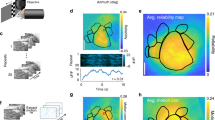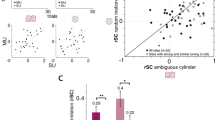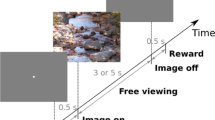Abstract
Natural visual scenes are cluttered with multiple objects whose individual features must somehow be selectively linked (or ‘bound’) if perception is to coincide with reality. Recent neurophysiological evidence1,2 supports a ‘binding-by-synchrony’ hypothesis3: neurons excited by features of the same object fire synchronously, while neurons excited by features of different objects do not. Moving plaid patterns offer a straightforward means to test this idea. By appropriate manipulations of apparent transparency, the component gratings of a plaid pattern can be seen as parts of a single coherently moving surface or as two non-coherently moving surfaces. We examined directional tuning and synchrony of area-MT neurons in awake, fixating primates in response to perceptually coherent and non-coherent plaid patterns. Here we show that directional tuning correlated highly with perceptual coherence, which is consistent with an earlier study4. Although we found stimulus-dependent synchrony, coherent plaids elicited significantly less synchrony than did non-coherent plaids. Our data therefore do not support the binding-by-synchrony hypothesis as applied to this class of motion stimuli in area MT.
This is a preview of subscription content, access via your institution
Access options
Subscribe to this journal
Receive 51 print issues and online access
$199.00 per year
only $3.90 per issue
Buy this article
- Purchase on Springer Link
- Instant access to full article PDF
Prices may be subject to local taxes which are calculated during checkout



Similar content being viewed by others
References
Gray, C. M., König, P., Engel, A. K. & Singer, W. Oscillatory responses in cat visual cortex exhibit inter-columnar synchronization which reflects global stimulus properties. Nature 338, 334–337 (1989)
Singer, W. & Gray, C. M. Visual feature integration and the temporal correlation hypothesis. Annu. Rev. Neurosci. 18, 555–586 (1995)
von der Malsburg, C. & Schneider, W. A neural cocktail party processor. Biol. Cybern. 54, 29–40 (1986)
Stoner, G. R. & Albright, T. D. Neural correlates of perceptual motion coherence. Nature 358, 412–414 (1992)
Stoner, G. R., Albright, T. D. & Ramachandran, V. S. Transparency and coherence in human motion perception. Nature 344, 153–155 (1990)
Stoner, G. R. & Albright, T. D. Motion coherency rules are form-cue invariant. Vision Res. 32, 465–475 (1992)
Stoner, G. R. & Albright, T. D. Luminance contrast affects motion coherency in plaid patterns by acting as a depth-from-occlusion cue. Vision Res. 38, 387–401 (1998)
Lindsey, D. T. & Todd, J. T. On the relative contributions of motion energy and transparency to the perception of moving plaids. Vision Res. 36, 207–222 (1996)
Singer, W. Neuronal synchrony: A versatile code for the definition of relations. Neuron 24, 49–65 (1999)
Bair, W., Zohary, E. & Newsome, W. T. Correlated firing in macaque visual area MT: time scales and relationship to behavior. J. Neurosci. 21, 1676–1697 (2001)
Movshon, J. A., Adelson, E. H., Gizzi, M. & Newsome, W. T. Study Group on Pattern Recognition (eds Chagas, T., Gattass, R. & Gross, C. G.) 117–151 (Pontifica Academia Scientiarum, Vatican City, 1985)
Rodman, H. R. & Albright, T. D. Single-unit analysis of pattern-motion-selective properties in the middle temporal visual area. Exp. Brain Res. 75, 53–64 (1989)
Castelo-Branco, M., Goebel, R., Neuenschwander, S. & Singer, W. Neural synchrony correlates with surface segregation rules. Nature 405, 685–689 (2000)
Pack, C. C., Berezovskii, V. K. & Born, R. T. Dynamic properties of neurons in cortical area MT in alert and anaesthetized macaque monkeys. Nature 414, 905–908 (2001)
de Oliveira, S. C., Thiele, A. & Hoffmann, K. P. Synchronization of neuronal activity during stimulus expectation in a direction discrimination task. J. Neurosci. 17, 9248–9260 (1997)
Kreiter, A. K. & Singer, W. Stimulus-dependent synchronization of neuronal responses in the visual cortex of the awake macaque monkey. J. Neurosci. 16, 2381–2396 (1996)
Thiele, A., Distler, C. & Hoffmann, K. P. Decision-related activity in the macaque dorsal visual pathway. Eur. J. Neurosci. 11, 2044–2058 (1999)
Batschelet, E. Animal Orientation and Navigation (eds Galler, S. R., Schmidt-Koenig, K., Jacobs, G. J. & Belleville, R. E.) 61–91 (NASA Aeronautics and Space Administration, Washington DC, 1972)
Aertsen, A. M., Gerstein, G. L., Habib, M. K. & Palm, G. Dynamics of neuronal firing correlation: modulation of “effective connectivity”. J. Neurophysiol. 61, 900–917 (1989)
Eggermont, J. J. & Smith, G. M. Neural connectivity only accounts for a small part of neural correlation in auditory cortex. Exp. Brain Res. 110, 379–391 (1996)
Stoner, G. R. & Albright, T. D. The interpretation of visual motion: evidence for surface segmentation mechanisms. Vision Res. 36, 1291–1310 (1996)
Acknowledgements
We thank J. Constanza and D. Diep for technical assistance. We also thank T. D. Albright, J. R. Reynolds, G. Boynton and J. Hegdé for discussions on this work and comments on the manuscript.
Author information
Authors and Affiliations
Corresponding author
Ethics declarations
Competing interests
The authors declare that they have no competing financial interests.
Rights and permissions
About this article
Cite this article
Thiele, A., Stoner, G. Neuronal synchrony does not correlate with motion coherence in cortical area MT. Nature 421, 366–370 (2003). https://doi.org/10.1038/nature01285
Received:
Accepted:
Issue Date:
DOI: https://doi.org/10.1038/nature01285
This article is cited by
-
A neural correlate of perceptual segmentation in macaque middle temporal cortical area
Nature Communications (2022)
-
Cortical-like dynamics in recurrent circuits optimized for sampling-based probabilistic inference
Nature Neuroscience (2020)
-
Cortical gamma band synchronization through somatostatin interneurons
Nature Neuroscience (2017)
-
A recurrent neural model for proto-object based contour integration and figure-ground segregation
Journal of Computational Neuroscience (2017)
-
A mechanism for graded, dynamically routable current propagation in pulse-gated synfire chains and implications for information coding
Journal of Computational Neuroscience (2015)
Comments
By submitting a comment you agree to abide by our Terms and Community Guidelines. If you find something abusive or that does not comply with our terms or guidelines please flag it as inappropriate.



